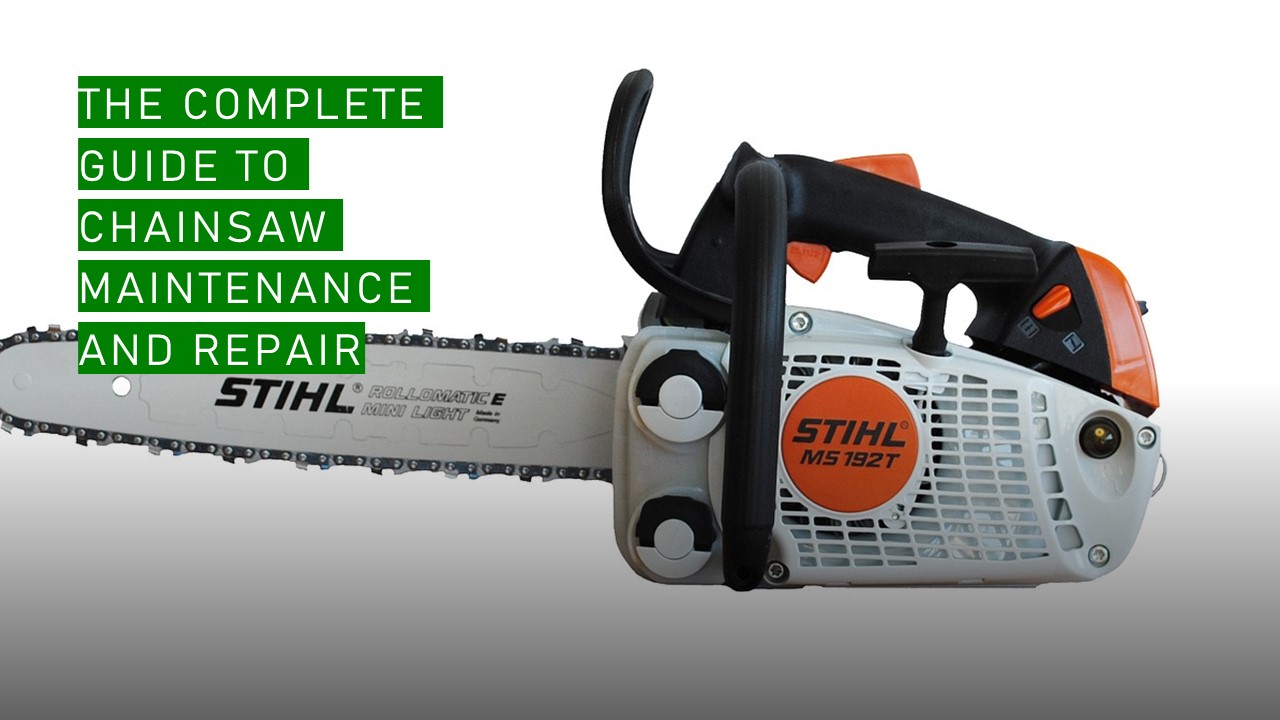Chainsaws are versatile and powerful tools used for various tasks, from cutting firewood to clearing trails and maintaining landscapes. To ensure that your chainsaw performs efficiently and lasts for years, regular maintenance and repair are essential. In this guide, we’ll cover everything you need to know about chainsaw maintenance, repair, and tuning. Whether you’re a seasoned chainsaw operator or a beginner, this article will help you keep your chainsaw in top condition.
Introduction to Chainsaw Maintenance
Chainsaws are reliable workhorses, but they require regular care to keep them running smoothly and safely. Neglecting maintenance can lead to reduced performance, safety hazards, and costly repairs. Here’s a quick overview of why chainsaw maintenance is crucial:
- Safety: A well-maintained chainsaw is less likely to malfunction, reducing the risk of accidents.
- Performance: Regular maintenance ensures that your chainsaw cuts efficiently and quickly.
- Durability: Proper care can extend the lifespan of your chainsaw, saving you money in the long run.
- Fuel Efficiency: A clean and well-tuned chainsaw uses less fuel, reducing operating costs.
Now, let’s dive into the specifics of chainsaw maintenance.
Basic Chainsaw Maintenance
Before we get into the nitty-gritty of chainsaw maintenance, let’s cover some fundamental steps that apply to all chainsaws:
a. Safety First
Always prioritize safety when working with a chainsaw. Wear appropriate protective gear, including a helmet, safety glasses, ear protection, gloves, and chainsaw chaps or pants.
b. Read the Manual
Start by thoroughly reading your chainsaw’s owner’s manual. It contains essential information specific to your model, including maintenance instructions and safety guidelines.
c. Chain Tension
Check and adjust the chain tension regularly. A loose chain can jump off the guide bar or cause kickback, while an overly tight chain can damage the bar and sprocket.
d. Chain Sharpness
Maintain a sharp chain for efficient cutting. You can either sharpen the chain yourself or take it to a professional sharpening service.
e. Lubrication
Ensure that the chain oiler is working correctly. Proper lubrication reduces friction and extends the life of the bar and chain.
f. Clean the Chainsaw
After each use, clean the chainsaw thoroughly, removing debris, sawdust, and oil residue. Pay attention to the air filter and cooling fins.
Chainsaw Cleaning and Maintenance
Cleaning your chainsaw is a crucial part of routine maintenance. A clean chainsaw not only looks better but also performs better and lasts longer. Here are the steps to clean your chainsaw:
a. Cleaning the Exterior
- Switch off: Ensure the chainsaw is turned off and the spark plug disconnected for safety.
- Remove debris: Use a brush or compressed air to remove dirt, sawdust, and debris from the exterior.
- Check for damage: Inspect the housing, handle, and other parts for any cracks or damage.
b. Cleaning the Air Filter
The air filter prevents dirt and debris from entering the engine. A clogged air filter can lead to poor performance and increased fuel consumption.
- Access the air filter: Refer to your owner’s manual to locate and access the air filter.
- Remove the filter: Take out the air filter and inspect it for dirt and damage.
- Cleaning options: Depending on your filter type, you can either tap it to remove loose dirt or wash it with soap and water for reusable filters.
- Dry thoroughly: Ensure the filter is completely dry before reinserting it.
c. Cleaning the Cooling Fins
Chainsaws have cooling fins that help regulate engine temperature. These fins can become clogged with dirt and sawdust, reducing cooling efficiency.
- Access the fins: Refer to your manual to locate the cooling fins on your chainsaw.
- Brush or blow: Gently brush or blow away any dirt or debris from the fins.
d. Cleaning the Spark Arrestor Screen
The spark arrestor screen prevents sparks from escaping the muffler and causing fires. A clogged screen can lead to reduced exhaust flow and decreased performance.
- Locate the spark arrestor: Refer to your manual to find the spark arrestor on your chainsaw.
- Remove the screen: Carefully remove the spark arrestor screen and clean it with a wire brush or replace it if necessary.
Chainsaw Bar and Chain Maintenance
The bar and chain are critical components of your chainsaw, and they require regular attention to ensure proper functioning. Here’s how to maintain them:
a. Chain Sharpness
A sharp chain is essential for efficient cutting. Dull chains not only slow down your work but also increase the risk of kickback.
- Sharpen the chain: Use a chainsaw file or an electric chain sharpener to maintain a sharp cutting edge.
- File angle: Follow the manufacturer’s recommendations for the correct file angle and depth.
b. Chain Tension
Proper chain tension is vital for safe and efficient cutting.
- Turn off the chainsaw: Always disconnect the spark plug before adjusting chain tension.
- Adjust the tension: Follow your owner’s manual to adjust the chain tension to the recommended specifications. Typically, the chain should be snug but still movable by hand.
c. Bar Maintenance
The guide bar should also be inspected and maintained regularly:
- Remove the bar: Loosen the bar nuts and remove the guide bar.
- Clean the groove: Use a flathead screwdriver or bar groove cleaner to remove debris from the bar groove.
- Inspect the bar: Check for signs of wear, such as a worn groove or bent rails. Replace the bar if necessary.
d. Lubrication
Proper lubrication is essential to reduce friction and prevent wear on the bar and chain.
- Check the oil level: Ensure the chainsaw’s oil reservoir is filled with chain oil.
- Adjust the oiler: Most chainsaws allow you to adjust the oil flow rate. Consult your manual for the correct setting.
Chainsaw Air Filter Maintenance
The air filter is a critical component that prevents dust and debris from entering the engine. Regular maintenance is essential to keep it functioning correctly.
a. Cleaning the Air Filter
- Access the air filter: Refer to your owner’s manual to locate and access the air filter.
- Remove the filter: Take out the air filter and inspect it for dirt and damage.
- Cleaning options: Depending on your filter type, you can either tap it to remove loose dirt or wash it with soap and water for reusable filters.
- Dry thoroughly: Ensure the filter is completely dry before reinserting it.
b. Replacing the Air Filter
If the air filter is damaged or excessively dirty, it’s best to replace it with a new one. Follow your owner’s manual for the correct replacement part.
Chainsaw Fuel System Maintenance
A well-maintained fuel system is crucial for the proper functioning of your chainsaw engine.
a. Fuel Mix
Ensure you’re using the correct fuel mix ratio specified by your chainsaw’s manufacturer. This typically involves mixing two-stroke engine oil with gasoline in the right proportions.
b. Fuel Quality
Use high-quality, ethanol-free gasoline to avoid engine issues caused by ethanol-related problems.
c. Fuel Filter
Check and replace the fuel filter if it’s dirty or clogged. A clogged fuel filter can restrict fuel flow and lead to poor engine performance.
d. Fuel Lines
Inspect the fuel lines for cracks or damage. Replace any damaged lines to prevent fuel leaks.
7. Chainsaw Clutch Maintenance
The clutch is a critical component that engages and disengages the chain. Proper maintenance ensures smooth operation.
- Inspect the clutch: Remove the side cover to access the clutch assembly.
- Clean and lubricate: Clean the clutch components and apply a small amount of lubricant if necessary.
Chainsaw Brake Maintenance
The chain brake is a safety feature that stops the chain from spinning in case of kickback or other emergencies. Regular checks are essential for safety.
- Test the chain brake: With the chainsaw off, engage and disengage the chain brake to ensure it functions correctly.
- Clean and lubricate: Remove the side cover and inspect the chain brake components. Clean and lubricate them as needed.
Specific Chainsaw Brands and Models Maintenance
Different chainsaw brands and models may have unique maintenance requirements. Here are some specific tips for popular brands and models:
1. Stihl Chainsaw Maintenance
Stihl is a well-known chainsaw manufacturer with a reputation for durability. To maintain your Stihl chainsaw:
- Follow the manufacturer’s recommended maintenance schedule.
- Pay close attention to air filter maintenance, as Stihl chainsaws are known for their high-quality filters.
- Use genuine Stihl replacement parts for repairs.
2. Husqvarna Chainsaw Maintenance
Husqvarna chainsaws are popular for their power and reliability. To keep your Husqvarna chainsaw in top shape:
- Regularly clean the air filter and cooling fins.
- Check the spark plug and replace it if necessary.
- Inspect the chain brake and clutch for proper operation.
3. Echo Chainsaw Maintenance
Echo chainsaws are known for their lightweight design and ease of use. For Echo chainsaw maintenance:
- Clean the air filter and spark arrestor screen frequently.
- Check the chain tension and sharpen the chain as needed.
- Ensure the chain oiler is functioning correctly.
4. Poulan Chainsaw Maintenance
Poulan chainsaws are affordable and suitable for light to moderate use. To maintain your Poulan chainsaw:
- Keep the air filter clean and replace it if it’s damaged.
- Check the fuel lines for cracks or leaks.
- Regularly inspect the chain for wear and tension.
5. Craftsman Chainsaw Maintenance
Craftsman chainsaws are known for their versatility. To maintain your Craftsman chainsaw:
- Clean the air filter and cooling fins regularly.
- Check the bar and chain for wear and proper tension.
- Inspect the fuel system, including the fuel filter and lines.
Electric Chainsaw Maintenance
Electric chainsaws are quieter and require less maintenance compared to their gas-powered counterparts. However, they still need attention to function optimally:
- Keep the chain sharp and tensioned.
- Check the power cord for damage.
- Clean the chain oiler if your electric chainsaw has one.
- Lubricate the chain if required, depending on the model.
Low Maintenance Chainsaws
If you prefer a chainsaw with minimal maintenance requirements, consider low-maintenance models designed for ease of use. These typically include features like tool-free chain tensioning and self-lubricating chains.
Mini Chainsaw Maintenance
Mini chainsaws are compact and lightweight, making them ideal for small cutting tasks. Maintenance for mini chainsaws is similar to that of full-sized chainsaws, with a focus on chain sharpness and tension.
Chainsaw Tune-Up
Regularly tuning up your chainsaw can improve its performance and extend its lifespan. Here are the key steps for a chainsaw tune-up:
- Replace the spark plug: Install a new spark plug for reliable ignition.
- Clean or replace the air filter: Ensure proper airflow to the engine.
- Inspect the fuel system: Check for leaks, and replace the fuel filter and lines if necessary.
- Sharpen the chain: A sharp chain reduces cutting time and strain on the engine.
- Check the chain tension: Adjust the chain tension according to the manufacturer’s recommendations.
- Inspect the guide bar: Look for signs of wear or damage and replace if needed.
- Lubricate the chain: Ensure the chain oiler is functioning correctly.
Performing these steps regularly will keep your chainsaw running smoothly and prevent costly repairs.
Finding Chainsaw Maintenance Services Near You
If you’re not comfortable performing chainsaw maintenance and repairs yourself, you can always seek professional help. To find chainsaw maintenance services near you:
- Ask for recommendations from friends, family, or fellow chainsaw users.
- Check with local hardware stores or chainsaw dealerships; they often offer maintenance services.
- Look for certified chainsaw repair shops in your area.
Conclusion
Proper chainsaw maintenance is essential for safety, performance, and longevity. Regularly inspect and clean your chainsaw, sharpen the chain, and follow the manufacturer’s recommendations for maintenance and tune-ups. Whether you own a Stihl, Husqvarna, Echo, Poulan, Craftsman, or any other brand of chainsaw, following these maintenance tips will keep your tool in excellent condition and ready for any cutting task that comes your way. With a well-maintained chainsaw, you’ll tackle projects efficiently and safely, all while prolonging the life of your valuable tool.





